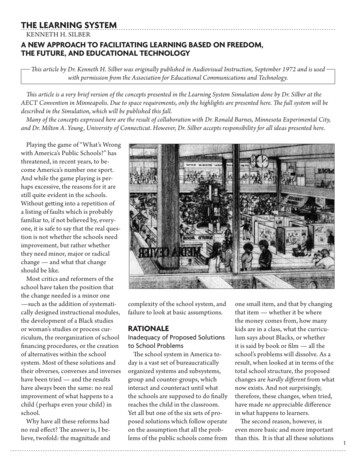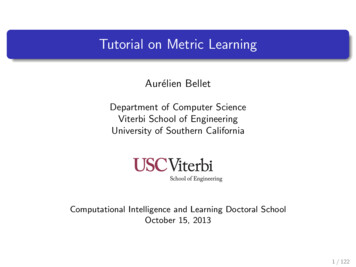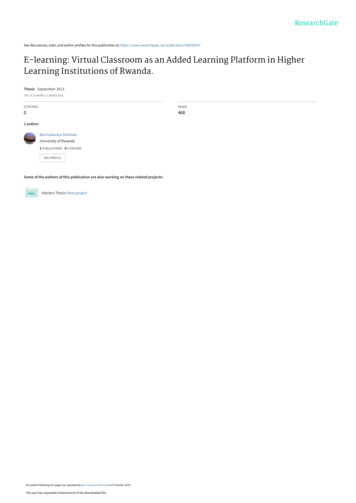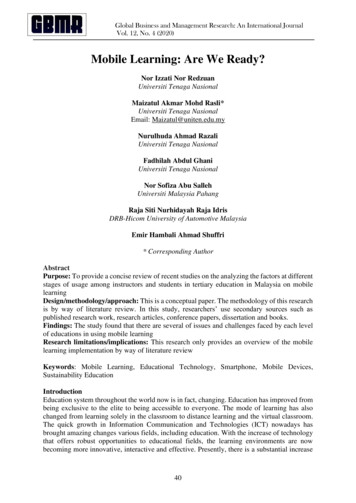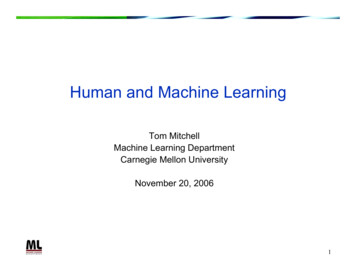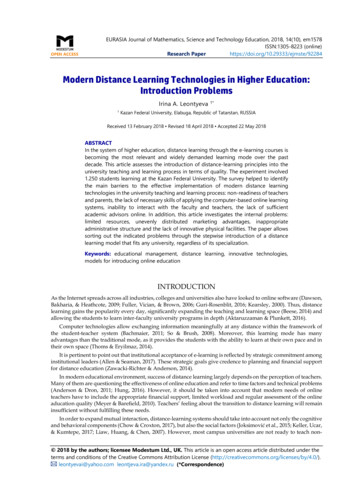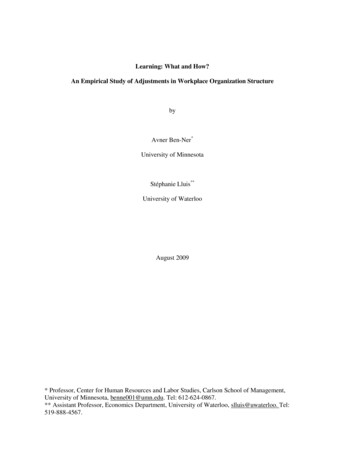
Transcription
Learning: What and How?An Empirical Study of Adjustments in Workplace Organization StructurebyAvner Ben-Ner*University of MinnesotaStéphanie Lluis**University of WaterlooAugust 2009* Professor, Center for Human Resources and Labor Studies, Carlson School of Management,University of Minnesota, benne001@umn.edu. Tel: 612-624-0867.** Assistant Professor, Economics Department, University of Waterloo, slluis@uwaterloo. Tel:519-888-4567.
Learning: What and How?An Empirical Study of Adjustments in Workplace Organization StructureAbstractIn this paper we seek to understand how firms learn about what adjustments they need to make intheir organization structure at the workplace level. We define four organizational systems:traditional (the simplest system), high-performance (the most complex system), decision-makingoriented, and financial-incentives oriented (intermediate complexity). We analyze (1) the effects oflearning-by-doing on adoption of more or less complex systems, (2) the shape of the performanceexperience learning curves associated with different systems, (3) the match between perceivedorganizational capabilities and the choice of systems, (4) the influence of other firms‘ systems andperformance on a firm‘s adjustment decisions, and (5) the effect of a firm‘s location on itsdecisions.JEL Codes: D83, L25, M54Keywords: Learning-by-doing, Matching, Social Learning, Vicarious Learning, OrganizationalAdjustments, Human Resources1
1. IntroductionThe period from the early 1980s to the middle of the 1990s was characterized by rapidchange, with rising globalization, heightened competition, political change, and rapid product andprocess technological change. To succeed or just to survive in this environment, many firmsadjusted their organization structure. At the level of the workplace, the change was frequentlyreflected in decentralization of decision-making and increased reliance on financial incentives(Appelbaum and Batt, 1994, Cappelli et al., 1997).Organizations are under constant competitive pressure to improve their organizationstructure in order to get workers and managers to perform better. How to do better consists of manyelements, two of which are central to understanding organizational change: identifying practicesthat impact behavior in desirable ways, and figuring out how to combine various practices to obtainmaximum synergy among them. In a world of full and perfect information, unboundedly-rationalmanagers would implement all available knowledge instantaneously and therefore organizationswould always be in internal and external equilibrium. The large literature that documents change inactual organizations suggests that, in reality, managers struggle to figure out what works and howto implement change in their organizations, and that the process is often a protracted one. Thisprocess may be summarized as learning.There is a substantial literature on organizational learning.1 The literature identifies threedominant learning mechanisms. In learning-by-doing, decision-makers learn from their experienceto improve their ability to operate a system (Yelle, 1979; Argote and Epple, 1990). In matching,decision-makers extract information about their firm‘s capabilities or absorptive capacity to operatea particular system (Cohen and Levinthal, 1990; Jovanovic and Nyarko, 1995, 1996). In social orvicarious learning, decision-makers learn from observing the behavior of others (March, 1991,Haunschild and Miner, 1997; Foster and Rosenzweig, 1995).In this paper, we investigate an original and unique dataset to test the influence of theselearning mechanisms on how firms adjusted their organization structure at the level of theworkplace during the period of early 1980s to the mid-1990s. We define organization structure onthe basis of decision-making and incentive practices, which we combine into four organizationalsystems: traditional (or simple, with centralized decision-making with fixed pay), high-performance(innovative or complex, decentralized decision-making and variable pay), and intermediate,1For example, Ichniowski and Shaw (1995) study why older firms take longer to adopt new practices, Pisano,Bohmer and Edmonson (2001) and Edmondson, Winslow, Bohmer and Pisano (2003) analyze learning fromorganizations in the health care industry, Sorenson (2003) focuses on the effect of a firm‘s internal structure onlearning outcomes among computer workstation manufacturers, Schwab (2007) looks at the relative impact ofmultilevel sources of information on adoption of an innovative managerial practice, and Rahmandad (2008)analyzes the impact of delays between actions and payoffs on learning in a simulated organization (earlierliterature on organizational learning is reviewed by Argote, 1999).2
decision-making and financial incentives. We study firms‘ choices with respect to these systems:adding, shedding and keeping practices. In the middle of the 1990s, we surveyed all publicly-tradedand a sample of privately-held Minnesota based firms, asking them to provide the dates ofintroduction of various practices concerning the group and firm-level decision-making andfinancial incentives, which we combined into the four systems.Figure 1 documents the significant decline in the proportion of firms with a traditionalsystem and the rise in the proportion of firms that have a high-performance or financial incentivessystem. The figure reflects the cumulative result of the choices made by each sample firm overtime, the choice being between continuation with the current organizational system and switchingto another system. Table 1 summarizes these choices and shows the disposition of the 855 annualdecisions that were made by the sample of publicly-traded firms between 1980 and 1994.2 Amajority of the firms (72.7%) had changed systems, with some more than once. Most transitionswere from the traditional into the financial incentives system, and from financial incentives into thehigh-performance system. Since we do not observe learning directly, we examine these choicestransitions relative to various signals and information that management may have received prior tomaking these decisions in order to infer about the process and nature of learning.This is the first paper to evaluate a wide spectrum of variables and firm characteristics thatinfluence learning during the 1980s, a period of major transformation in firm organizationalstructures. We allow for the possibility that firms learn in multiple ways and from multiple sourcesof information, internal (accumulation of experience and changes in performance) as well asexternal (industry-level adoption rates and average performance, distance to largest city).3 We alsoexamine the effects of different learning mechanisms on financial performance. A sizable literaturehas investigated the determinants of adoption of human resource systems, but our dataset permits toanalyze the timing of adoption and its consequences on firm performance.4The organization of the paper is as follows. In the next section, we develop the conceptualframework for studying learning by organizations and offer the main hypotheses. In section 3, we2Most of the analysis in the paper focuses on public firms for which we have financial performanceinformation needed for understanding the matching mechanism and learning curves. In an appendix, wepresent analysis of learning by-doing and social learning in private firms, where no financial information isrequired.3Zimmerman (1982), Irwin and Klenow (1994), Henderson and Cockburn (1996), Thompson and Thornton(2001) and Schwab (2007) adopted a similar approach of simultaneously analyzing different sources oflearning. They focused on the effects of learning from a firm‘s own experience relative to learning from itscompetitors. Our study extends their approach to include a larger set of learning mechanisms. Moreover, byanalyzing firms in a cross-section of industries, our results generalize beyond single-industry or single-firmlearning phenomena.4The literature investigates why firms have certain organizational practices or systems and how these affectperformance, rather than the process through which they come to adopt those practices; see, for example,Osterman (1994), Jones and Kato (1995), Ichniowski, Shaw, and Pernushi (1997), Cappelli and Neumark(2001).3
describe the data and in section 4 we detail our analytical framework and empirical strategy. Theresults are described in section 5, and in section 6 we conclude with a discussion of theimplications of our findings for the understanding of learning by organizations as well as forfurther research.2. Learning by Organizations: Discussion and HypothesesThe organization that succeeds in extracting better, smarter, and more economical effortfrom its employees will, ceteris paribus, perform better than other organizations. To accomplishthis, certain management practices must be put in place to meet an organization‘s needs andcapabilities. Because the payoff for doing things right in a competitive environment is high, and thepenalty for doing things wrong is severe, organizations have an incentive to learn how to do thingsright. Three different approaches to learning have been developed in the literature. The firstapproach emphasizes the accumulation of capabilities through experience; this is the learning-bydoing theory. The second approach focuses on the accumulation of information about the firm‘scapabilities; this is the matching theory of learning. The third approach concentrates on how a firmobserves what other firms do and draws inferences about what may be useful to emulate; this is thesocial learning theory. The mode of learning and the combination of sources from whichinformation is drawn are likely to depend on the object of learning, such as organizationalstructure. We develop the three approaches with reference to learning about organization structure,which we discuss briefly below before turning to the three learning mechanisms.2.1 Organizational structure in the workplaceThe allocation of decision-making and financial returns is considered in the economicsinspired literature as the central element of organizational structure (e.g., Hart and Moore, 1990,Ben-Ner and Jones, 1995 and Brickley et al., 2007). Focusing on these elements, we distinguishamong four organizational systems on the basis of their reliance on employee involvement indecision-making through teamwork and similar mechanisms, and reliance on group or firm-levelincentives such as group bonus, profit sharing, and employee stock ownership. The four systemsare the traditional system, which entails centralized decision-making and fixed pay; the decisionmaking system, which implements decentralization of decision-making via employee involvementbut is associated with fixed pay; the financial incentives system, which relies on group and firmlevel financial incentives but not employee involvement in decision-making; and the highperformance system, which combines the decision-making and financial incentives systems. Thisclassification is summarized in Figure 2.5 Moving away from the traditional system entails a moveto a more complex management challenge. There are alternative ways of aggregating diverse5These four systems are equivalent to cells OA1-OA4 in Table 1 of Ben-Ner and Jones (1995).4
practices into systems; these four systems may be complemented by additional practices, such astotal quality management, training, monitoring, employment security and more (Prendergast, 2002and Ben-Ner, Kong and Lluis, 2007); we discuss alternative categorizations of systems in section5.5.1.The four systems differ in terms of the organizational capabilities necessary for their effectiveoperation, the costs of operating them, and the benefits that stem from their operation.Organizational capabilities concern a complex set of skills, know-how, and traditions that reside inmany parts of an organization, in both management and workers, but cannot be observed directly(Nelson and Winter, 1982, Chandler, 1992). Organizational capabilities reflect the ability ofmanagers to select mechanisms for allocation of decision-making, incentives to induce employeesand managers to act in the organization‘s interests and to put in place supporting practices such astraining and organizational culture to promote a sense of duty and dedication to ameliorate freeridership in ways that cannot be accomplished with incentives alone (Kreps, 1990, Kandel andLazear, 1993, Ben-Ner and Jones, 1995). Organizational capabilities reside in managers andworkers; training or replacement may enhance organizational capabilities, but the fact that hiringand training are commonly done by existing staff prevents significant transformation of a firm‘scapabilities, resulting in a nearly fixed level of organizational capabilities.6 Organizationalcapabilities also relate to the firm‘s absorptive capacity, the ability of a firm to recognize andassimilate the value of new information (Cohen and Levinthal, 1990).The costs required to operate a system effectively rise with its complexity (Ichniowski andShaw, 1995). The high-performance system is the most costly because it requires both investmentsin training to enable employees to make sound decisions and financial resources to provideeffective incentives. The decision-making and financial incentives systems entail lower costs thanthe high-performance system; it is impossible to rank these systems without specific operationaland contextual details. The lowest-cost system is the traditional system. The magnitude of thebenefits a firm can reap increases with organizational capabilities. Poor management can causesevere performance problems, and the more complex the system the more severe are the problems.In contrast, a firm possessing superior organizational capabilities can take advantage of thepotential of the high-performance system and can generate a higher level of performance than itcould from employing any other system. Thus in equilibrium a high-capability firm performs best,that is, generates the largest net benefits with the high-performance system, whereas a lowcapability firm performs best when it employs the traditional system. The intermediate systems6In a study asking respondents in U.S. and Japanese semiconductor firms to rate the importance of differentsources of information affecting decision-making, the most important source of information in both countrieswas colleagues in their own company (Appleyard, 1996).5
yield greater benefits when supported by appropriate organizational capabilities, which rank inbetween the levels required by the traditional and high-performance systems.The decision-making system cannot operate effectively without the complement offinancial incentives because self-interested employees and management may use their decisionmaking power to pursue activities that benefit them rather than the organization (Levine and Tyson,1990). Similarly, a financial system may provide appropriate incentives but in the absence ofdecentralization and delegation of decision-making employees and managers cannot act on theirincentives. Only the high-performance system can take advantage of the complementarity betweenfinancial incentives and decision-making delegation; an intermediate system will perform worsethan a high-performance system and possibly worse even than the traditional system (Ben-Ner andJones, 1995, Appelbaum et al., 2000).Why would a firm adopt an intermediate system? The process of transition from thetraditional to the high-performance system entails not just the formal addition of incentives and theshifting of decision-making responsibilities to line employees, but also a complicated restructuringof myriad relationships among employees (Gant, Ichniowski, and Shaw, 2002). Firms with limitedorganizational capabilities or strong internal resistance to change will not make the transition in oneleap; instead, they will move temporarily to an intermediate system, and then move on to the highperformance system. This is compatible with the two-stage transitions observed in Table 1.2.1 Learning-by-DoingArrow‘s (1962) seminal contribution focused on the role of experience on organizationalproductivity; subsequent investigations examined the process of introduction, implementation, andassimilation of new production technologies. A key argument of this literature is that the mastery ofa new technique by an organization requires adjustments and learning by many individuals whoparticipate in production. This process takes time, and the initial productivity of a new technologywill be only a fraction of its full potential. The theory predicts, and empirical findings generallysupport, the existence of a learning curve that implies that the productivity of a new technologyrises over a few years, then levels off (Epple, Argote and Devadas, 1991, Cabral and Leiblein,2001).Learning from experience enhances organizational capabilities. It may improve anorganization‘s ability to exploit more productively its current system, in line with the principalpredictions of theory. Experience may also generate organizational knowledge that enables a firmto operate a more system than the firm‘s current system and thus be able to take advantage of itsgreater productivity. For a firm that accumulates knowledge that is transferable to more complexsystems, as its capabilities grow over time, at some point they will reach the threshold level forswitching to a more complex system.6
Learning-by-doing has implications for the dynamics of firm performance. The typicallearning curve exhibits an initial period of adjustment to the new system, after which productivityincreases with experience but at a decreasing rate and eventually levels off. Firms with differentcapabilities accumulate experience at different rates, leading to different learning curves. Thereforethe productivity profiles of firms with the high-performance system should be above the profile offirms with the traditional system – assuming that they adopted the systems that match theircapabilities.7The discussion above focused, for the sake of presentational convenience, on the traditionaland the high-performance systems. The discussion can be extended to the four systems. Thedecision-making and financial systems are more complex than the traditional system but less sothan the high-performance one, but the two intermediate systems cannot be ranked and we willtreat them as equally complex, and extend the predictions derived for the two systems to includethe third intermediate possibility. Formally:Hypothesis 1: The probability of switching to a more complex system increases with experience(H1a). Firm productivity increases with experience with a given system, but the rate of increasedecreases over time (H1b).The productivity profile of firms matched with the high-performancesystem is above the productivity profile of firms matched with the less complex system (H1c).2.3 Learning About the Match Between a Firm’s Abilities and its SystemHow do managers learn about their firms‘ ability to operate different systems? TheBayesian learning literature suggests that managers have some prior beliefs about their firms‘organizational capabilities and update them using signals they receive over time.8 If the perceivedcapabilities exceed a certain threshold, management will decide to switch to a more complexsystem; otherwise it will stay with the current one. Managers update their beliefs on the basis ofsignals they extract from observing previous performance: a switch to a more complex system willfollow improvements in performance, if those are large enough to bring expected capabilities abovethe threshold for switching systems. Formally:7The idea that firms in the same industry vary in their learning rates was first illustrated by Dutton andThomas (1984), documented across different plants of the same firm using the same technology by Chew,Bresnahan and Clark (1990) and by Pisano, Bohmer and Edmondson (2001) for cardiac surgery departmentsimplementing a new technology.8This literature was initiated by Jovanovic (1979) concerning worker mobility and later applied to firm behaviorin Jovanovic (1982) and Jovanovic and Nyarko (1995) and to firm choice of technology in Jovanovic and Nyarko(1996). This is similar to the idea of performance feedback, according to which firms adjust a given practiceincrementally based on performance (Greve, 2003). Gibbons and Waldman (1999) analyze a model of learningbased on time-dependent shocks in which promotion decisions arise following previous period improvements inworker performance.7
Hypothesis 2 (H2): The likelihood of switching to a more complex system increases withimprovements in performance.2.4 Social learningFirms adjust their organizational structure not only by looking inward at their ownexperiences, but also by learning effective management practices from consultants, colleagues inprofessional organizations, and academics, as well as observing the actions of other firms. Otherfirms‘ experiences may supply information or signals about the costs and benefits of systems withwhich managers do not have direct experience. In particular, managers of firms with the traditionalsystem do not know precisely the costs and benefits of the high-performance system, and thereforedo not know the threshold level of organizational capabilities that a firm must possess in order tomake a successful switch.Managers may emulate other firms also to gain legitimacy with employees, customers,suppliers, and others on whom they depend (DiMaggio and Powell, 1983). Not all emulation isbeneficial: managers may follow others in ―herd behavior‖ fashion at the expense of more relevantsignals, which is likely to result in inferior performance (Banerjee, 1992). Learning from theexperience of others may complement or even substitute for learning from one‘s own experience.The information managers seek and the value of what they learn from others may becorrelated with their firms‘ abilities. Large firms enjoy economies of scale in collecting informationabout their environment. Firms located near other firms are better placed for networking withcolleagues and others who possess useful knowledge than are isolated firms (Jaffe, Trajtenberg andHenderson, 1993, Beaudry and Breschi, 2003, Erickson and Jacoby, 2003). Firms located in or nearlarge metropolitan areas usually have these advantages, as well as relatively easy access to sourcesof information - conferences, professional enhancement courses, consultants, academics, andhigher-quality managers and employees—compared to firms located farther away (Epple, Argoteand Murphy, 1996, Audretsch and Lehman, 2005).Information pertaining to a firm‘s own industry is more valuable than information fromother industries, which may have different economic and technological circumstances. A relativelysimple indicator of what other firms do is captured by the prevalence of firms using differentsystems. A richer (but harder to obtain) signal is the performance of firms with different systems,especially in a firm‘s own industry (Haundschild and Miner, 1997). Formally:Hypothesis 3. The likelihood of switching to a more complex system decreases with the degree of afirm’s isolation from other firms (H3a) and increases with the proximity to a metropolitan center(H3b). The likelihood that a firm will switch to a particular system increases with the proportion offirms practicing that system (H3c) and with the average performance of firms practicing that8
system (H3d). The effects are weaker when the system proportion and performance measuresconcern other industries as compared to the firm’s own industry (H3e).The three mechanisms may be used by the same firm as it seeks to learn about its ownorganizational capabilities and the costs and benefits of alternative systems, and from its ownexperience. The hypothesis testing in the next section allows explicitly for this possibility.3. Data and Variables3.1 The DatasetWe assembled a rich dataset concerning more than 800 privately-held and publicly-tradedfirms. The variables used in the analysis are summarized in the Appendix, where a discussion ofsample size differences across various estimations is also provided. For coherence andcompleteness of analysis, we focus our attention on the sample of publicly-traded firms for whichwe have financial information, our performance outcome. We replicated the analysis for the fullsample of firms and report the main results but do not include them in the paper (they are availableupon request). The description of the dataset below focuses on the publicly-traded firms. Weobtained data on various management practices, unionization status, geographic location, and otherfirm characteristics from the Minnesota Human Resources Management Practices Survey. Wageand employment data come from the Minnesota Department of Economic Security‘sunemployment insurance (UI) files, and financial data from Standard and Poor‘s Compustat.The survey was administered in 1994 to all publicly-traded firms with at least 20employees that were headquartered and operated in the state of Minnesota. The survey wasconducted by mail, with a phone survey administered to firms that did not respond. The overallresponse rate was 61% (177 firms), a rate that exceeds that of most similar surveys. The surveyasked for information about current practices in the responding firms as well as retrospectiveinformation regarding the dates of introduction and discontinuation of various practices.9 For eachresponding firm we thus had variables indicating the presence or absence of various humanresource practices over time as well as the introduction and discontinuation dates, whereapplicable, of these practices. For each firm we merged, when available, financial data fromCompustat and employment and average wage data from UI files. Because the UI data wereavailable only from 1980 on, we confined our analysis to the period from 1980 to the year of thesurvey, but when we use experience variables (how long a practice was in place), we employ theactual date when a practice was introduced, even if that was prior to 1980. The sample period is9Respondents were typically the highest human resources executive in the firm; in smaller firms therespondent was frequently the top executive in the firm. We debriefed several respondents about how theyobtained retrospective information about dates of introduction and discontinuation of practices; we were toldthat it came mostly from company records or their colleagues‘ recollections.9
therefore 13 years (the use of lagged changes in firm performance implies that we lose two years ofdata). Our panel dataset is anchored in the year of the survey and its size gets smaller the further wego back away from 1994.10 Among the 110 firms with all the requisite data (as compared to the 177responding firms), there were 39 firms in 1980, with others having been established in later years.Firms may enter and exit the sample relative to the annual availability of financial data (ROI, themost limiting variable in our dataset). Consequently, a firm is in the sample for an average of 7.8years.3.2 VariablesWe constructed the dummy variables that represent the four systems, the key dependentvariables in this paper, as follows. The variable that represents the system that entails employeeinvolvement in decision-making (D) is coded 1 in year t if the firm had at least one of the followingemployee involvement programs in that year: quality of working life teams, quality circles,autonomous work teams, joint labor-management teams, or employee representatives on the boardof directors. The variable that represents the financial incentives system (F) is coded 1 if the firmhad at least one of the following: an employee stock ownership or purchase plan, a current ordeferred profit-sharing plan, a gain-sharing plan, or a group bonus plan. The high-performancesystem (H) was coded 1 if the firm had both F 1 and D 1, whereas the traditional system (T) wascoded 1 if the firm had both F 0 and D 0.In terms of system changes, 72.7% of firms (80 out of 110 firms) experience at least onesystem switch. Table 1 provides the number of potential and actual transitions across systems(where the unit of observation is firm-year). About 90% of the potential transitions entailed adecision to stay with the current system. Most of the actual transitions represent switching from thetraditional system to the financial incentives, decision-making, and high-performance systems,followed by switches from the financial incentives system to the high-performance system. Thehigh-performance system is the most stable one, with only five moves out of it, none of which areto the traditional system.Multiple variables were used to characterize the different learning mechanism. For learningby-doing, we use information on the number of years of experience with a system (includingexperience prior to 1980, as this variable does not require wage or employment information). It isimportant to keep in mind the differential effects of time and experience when modeling the effectof learning-by-doing with a system on decisions to adopt more complex systems. Experience with asystem can start only when the practices that define it become available. The innovative practices10Some of the firms that went out of business before the 1994 survey were likely poor performers who, amongother things, did not adjust their systems as well as surviving firms. Hence analysis of adjustment by survivorswill likely show a stronger pattern than that of non-survivors.10
became available in early to mid-1980s, which is when our sample period starts. As a result, thesystem with which firms have most experience is, of course, the traditional system, whereas thehigh-performance system, being the most re
learning mechanisms on how firms adjusted their organization structure at the level of the workplace during the period of early 1980s to the mid-1990s. We define organization structure on . monitoring, employment security and more (Prendergast, 2002 and Ben-Ner, Kong and Lluis, 2007); we discuss alternative categorizations of systems in section

